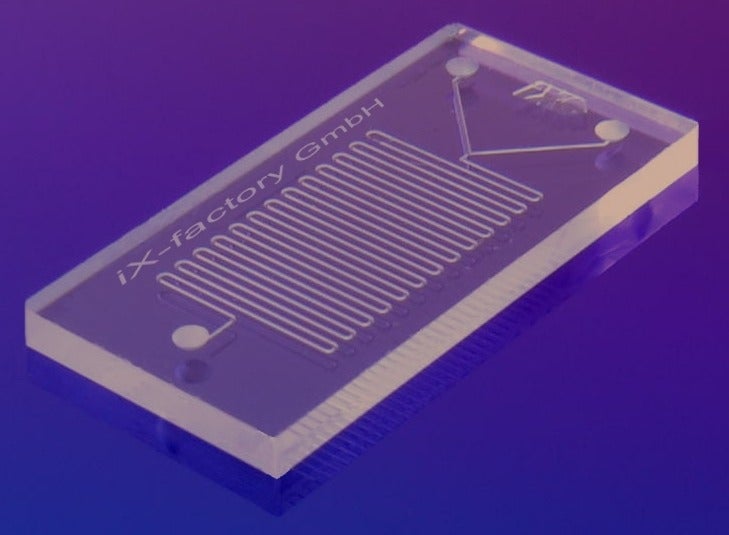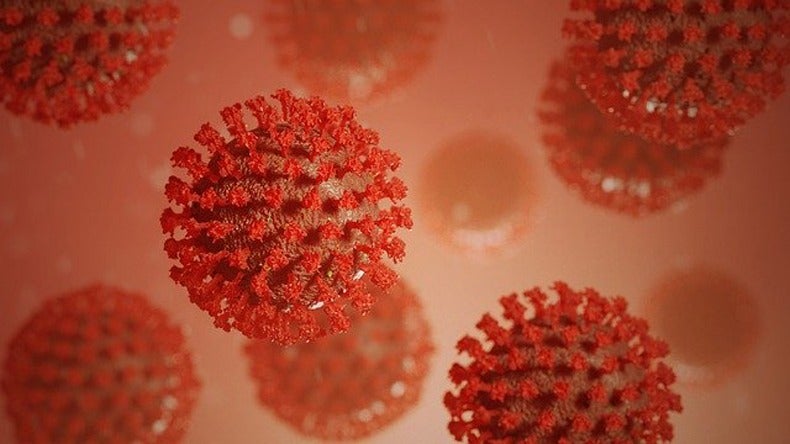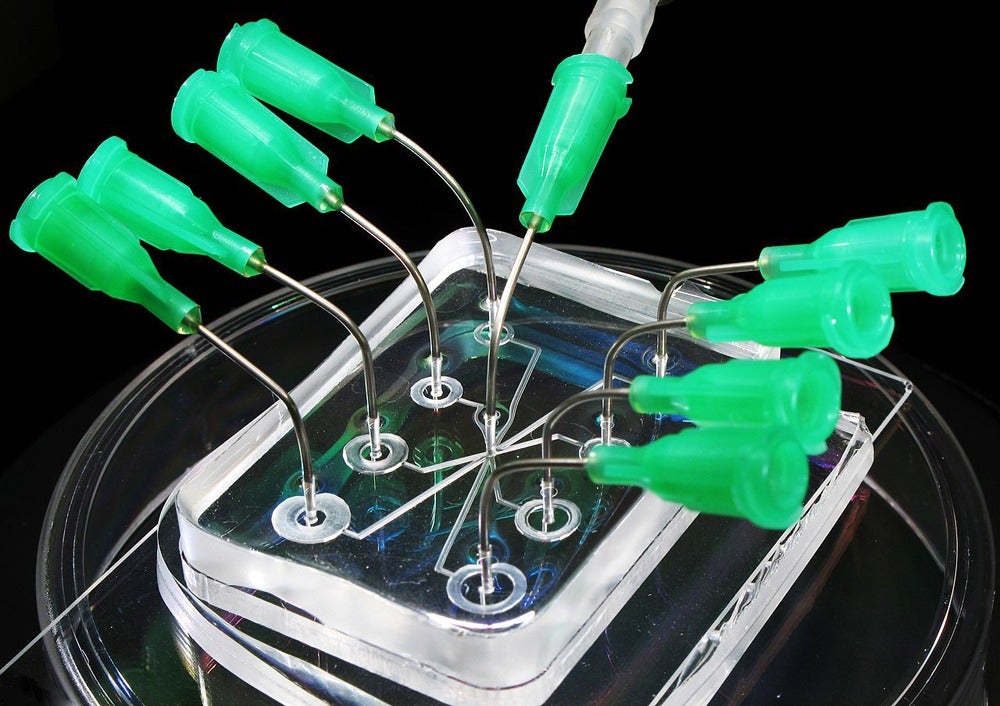
With the Covid-19 pandemic highlighting the need for fast affordable test kits, Dr Thomas Roland Dietrich, Ivam’s CEO, outlines why microfluidics is a growing area in the healthcare industry. He draws attention to its wide-ranging applications and benefits, including the technology’s portability and suitability for emerging markets across the globe.
Microfluidics deals with the behaviour, precise control and manipulation of fluids in channel systems, where typical dimensions go into the submillimetre scale. It is a multidisciplinary field that intersects with engineering, physics, chemistry, biochemistry, nanotechnology and biotechnology.
Typically, fluids are moved, mixed, separated or otherwise processed. A lot of applications use passive fluid-control techniques, like capillary forces. In others, external actuation is used to directly transport media. For manipulating the working fluid, active components, such as micropumps or microvalves, are used. Processes that are normally carried out in a lab are miniaturised on a single chip, to enhance efficiency and mobility, as well as reduce sample and reagent volumes.
Microfluidic reactors typically have heat exchange coefficients of up to 500MW m−3 K−1 compared with a few kilowatts in conventional glassware. Therefore, microreactors can remove heat much more efficiently than vessels and even critical, highly exothermal reactions can be performed safely. Heating and cooling a microreactor is also quicker. It is even possible to have different temperature zones on one microfluidic chip within a short geometrical distance. As a result of the superior heat transfer, reaction temperatures may be higher than in conventional batch reactors to allow faster reaction rates.
The operation in these systems is continuous, enabling the subsequent processing of unstable intermediates, while avoiding typical batch work-up delays. Intermediate, especially unstable products, are no longer stored for hours until the dosing of reagents is finished, so the next reaction step may be performed. This rapid work-up prevents the decay of precious intermediates and improves selectivities.
One advantage of these particular reactors is rapid mixing, due to the short diffusion distances of such devices. It is often reported that high-purity products can be obtained, without creating waste because of the suppression of side reactions that occur as a result of poor mixing in batch reactors.
As microreactors have a small internal volume, safety is guaranteed. Critical mass can be avoided. For safety reasons, temperatures and pressures in conventional processes are usually kept low. In microreactors, new process windows are possible, such as applying a high pressure and temperature to increase the velocity of the reactions or to steer them in the right direction.
Manufacturing and materials for microfluidic chips
The availability of microelectromechanical systems (MEMS) has enabled the fabrication of microfluidic devices, which can be reliably and uniformly mass-produced using processing technologies adapted from the semiconductor industry.

Microfluidic components, such as channels, jets, nozzles, reservoirs and complete functional chips, can be manufactured with robust materials, including silicon, glass, fused silica and metals. Polymer materials can also play an important role for single-use or disposable-test chips. Microfluidic chips usually have a series of microchannels that are etched or moulded onto the surface of one substrate, which are then bonded to another substrate to form closed channels. Complex microfluidic systems can then be built up by connecting microfluidic channels in several structured layers.
Modern production concepts that digitalise production processes, like smart production or Industry 4.0, provide new opportunities for the cost-effective manufacturing of microfluidic chips – even in small quantities. The idea is to manufacture the exact design necessary for a specific application, to produce it just in time and in the amount needed. For this, new production processes have been developed using a variety of methods, including 3D-polymer printing or the laser structuring of inorganic materials, like glass.
Applications in chemistry and healthcare testing
Chemists have traditionally used batch reactors (test tubes, round-bottomed flasks and stirred tanks) to conduct synthetic chemistry. From a process chemistry perspective, a major problem observed in conventional-batch technology is the failure to scale-up successful reactions. In industry, this often means redeveloping synthetic routes on several occasions when transferring from laboratory to pilot scale, and then finally to production. This is a time-consuming and costly process.
More recently, the chemistry community has introduced ‘continuous-flow’ synthesis as an alternative to batch processing. A key advantage of flow-reactor technology for the organic chemist is the ability to control reaction parameters accurately while improving safety; for example, regulating temperature and concentration is crucial for maintaining control over a reaction to ensure selective product formation and improve safety. Due to the excellent heat, and mass transfer and predictable-flow properties exhibited by microflow reactors, a high degree of reaction control is attainable. Along with increasing the rate of mixing, decreasing the channel diameter of the reactor results in an inherently high surface to volume ratio, allowing rapid dissipation of any heat generated over the course of a reaction.
Increasing issues with chronic diseases, an ageing population, and the health needs of emerging countries has led to a growing demand for point-of-care (POC) testing and rapid technological changes in molecular diagnostics. These are the major factors supporting the growth of the microfluidics market for lab-on-a-chip components. Microfluidic products, such as analysers, polymerase chain reaction (PCR) and electrophoretic systems, are used in diagnostics, agriculture, forensics, water testing and environmental screening.

Microfluidic devices provide various advantages due to their compact size, increased frequency of testing, and accurate and quick analysis. Such diagnostic technologies can be used in global health applications because they are disposable, inexpensive, portable and easy to use. These powerful tools are key for diagnosis and monitoring infectious diseases, especially in developing countries. Microfluidic platforms that manipulate small fluid volumes can be used to improve medical diagnosis in a rapid and accurate manner.
POC diagnostics should be able to analyse small volumes of bodily fluids, like blood, saliva and urine. Because of the contagious nature of these samples, the devices should be disposable to protect end-users from exposure to biohazardous waste.
In addition, disposable POC devices eliminate unnecessary steps, such as washing processes between sample preparations, which can make them easier to use, particularly in regions where access to water is limited. The cost of diagnostics is also one of the important parameters for global health applications. To decrease the cost of POC diagnosis, several aspects should be considered, including inexpensive manufacturing for mass production and miniaturisation.
A large number of different sensors are used with or included in microfluidic chips for measuring temperature, pressure, flow, pH, oxygen, particles and chemical or biological components. To improve the sensitivity, nanostructures, such as nanotubes, nanowires and cantilevers, are used to characterise various analytes that have previously been difficult to detect via conventional technologies. These sensors, which detect picomolar concentrations of label-free DNA, for example, have a high amount of sensitivity to molecular detection, and are potentially beneficial to the development of nano/microfluidic POC devices that enable label-free detection and the identification of actual virus particles in low concentration.
Most microfluidic POC devices have the potential to meet clinical and technical requirements for global healthcare needs, but a major challenge centres on how to establish regulations and standards that can evaluate microfluidic POC diagnostics for clinical use. To get approval for the legal clinical use of POC devices, microfluidic technologies should be capable of satisfying critical evaluation criteria; however, this is still an unsolved issue that slows down the speed of development for new medical products with microfluidics.
Point-of-care use by medical and non-medical personnel
Future challenges for the global health systems will accelerate the growth of the microfluidics market. The ability of POC diagnostic tests to provide immediate results, combined with digital procedures, like picture archiving, and communication systems (PACS) and electronic medical records (EMR), have accelerated the success of POC devices. This technology is not only useful in densely populated regions, but has also improved the patient reach for diagnostic services in rural areas, significantly impacting market growth.
Shortages of skilled medical staff are also expected to increase market penetration rates of POC diagnostic products. Medical and non-medical personnel – including the patient – with minimal training can use these devices.
Promising new technologies and applications indicate microfluidics has a bright future.






